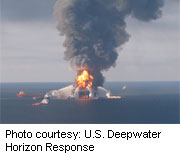
WEDNESDAY, April 6 (HealthDay News) — The true health toll of the massive Deepwater Horizon oil spill in the Gulf of Mexico last spring may never be known, a new review suggests.
Although a large study being conducted by the U.S. National Institute of Environmental Health Sciences (NIEHS) should provide some answers, it was started six months after the incident so initial levels of exposure to various chemicals may not be precisely recorded.
“The major study looking at the health effects didn’t get into the field until this January,” said review author Dr. Bernard Goldstein. “It’s going to be hard to get that exposure information without at least some noise in it and making it that much more difficult to see cause-and-effect.”
The review is published in the April 7 issue of the New England Journal of Medicine.
“Many scientists and community members share the concern expressed by the authors about the delays in implementing the study,” said Miriam Rotkin-Ellman, a public health scientist with the Natural Resources Defense Council in San Francisco.
That said, she added, “it’s not a too-little-too-late thing by any stretch of the imagination. This needs to be implemented to evaluate the current health status of the folks who were on the front lines.”
As many as 200 million gallons of crude oil may have spilled into the Gulf of Mexico after BP’s Deepwater Horizon rig exploded and sank on April 20, 2010. The accident quickly eclipsed the 1989 Exxon Valdez spill in magnitude.
More than 50,000 workers were involved in the clean-up effort, which differed from previous similar disasters in a number of ways, not the least of which was the release of more than a million gallons of oil dispersants with unknown health consequences.
“The magnitude of the spill, the 55,000 workers, this is a huge number of people drawn from a large geographic area doing a diverse set of clean-up tasks,” Rotkin-Ellman said. “The chemistry of the oil is actually changed by being a subsurface leak that was treated with dispersants, so it behaved differently. The duration, the impact — this went on for months. And also from the nonchemical exposure side, the degree of economic destruction these communities experienced is also unprecedented.”
A little is known about the acute, immediate effects of the spill. “The most important, which we should never forget, are the 11 men who died aboard that rig,” said Goldstein, who is professor of environmental and occupational health at the University of Pittsburgh Graduate School of Public Health.
Thirty workers were also seriously hurt, and countless other workers and residents of the nearby shoreline communities reported respiratory problems, skin irritation, headaches, nausea and dizziness.
Still, Goldstein said, “despite real challenges for the clean-up workers because of working in the heat in the summer, there was a pretty good job done compared to the past of protecting workers. Was it perfect? Are all the workers completely free of any effects, that’s not clear and we won’t know for some time.”
The other heartening news was that the compounds scientists have been most worried about, notably the carcinogen benzene, dispersed pretty quickly.
“Those at a distance from where the oil was bubbling up probably had negligible exposure to benzene,” Goldstein said.
Less is known about other compounds that were released, including another carcinogen, polycyclic aromatic hydrocarbons (PAHs).
“As much as we do know, exposures were probably not great,” said Goldstein.
There’s also the mental health toll. The authors noted that there have been more calls to mental health and domestic violence hotlines in the Gulf area since the Deepwater spill, and these people were already struggling with the immense after-effects of Hurricane Katrina.
Concerns about the nation’s supply of seafood, so much of which comes from that area, is also an issue. Again, the authors stated, little is known about how chemicals released during the disaster, including dispersants, might affect this part of the food supply.
“It’s still unclear what the ultimate health effects or outcomes will be from a disaster of this magnitude,” said Robert Emery, vice president for safety, health, environment and risk management at the University of Texas Health Science Center at Houston.
But he added, “the [NIEHS] study holds the promise of creating a comprehensive database for assessing any of a wide variety of possible effects of oil spills, examining not just exposures and toxicological effects, but also stress-related issues, effects of combined exposures and environmental influences.”
More information
Learn more about the Gulf study.

